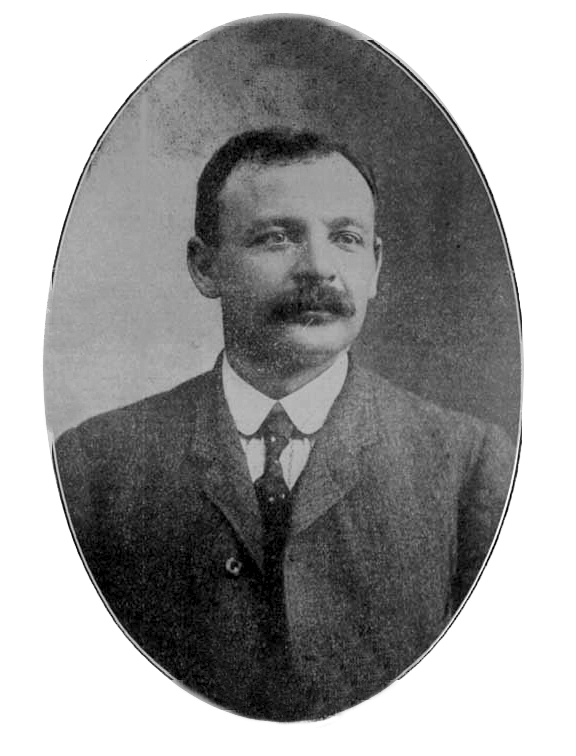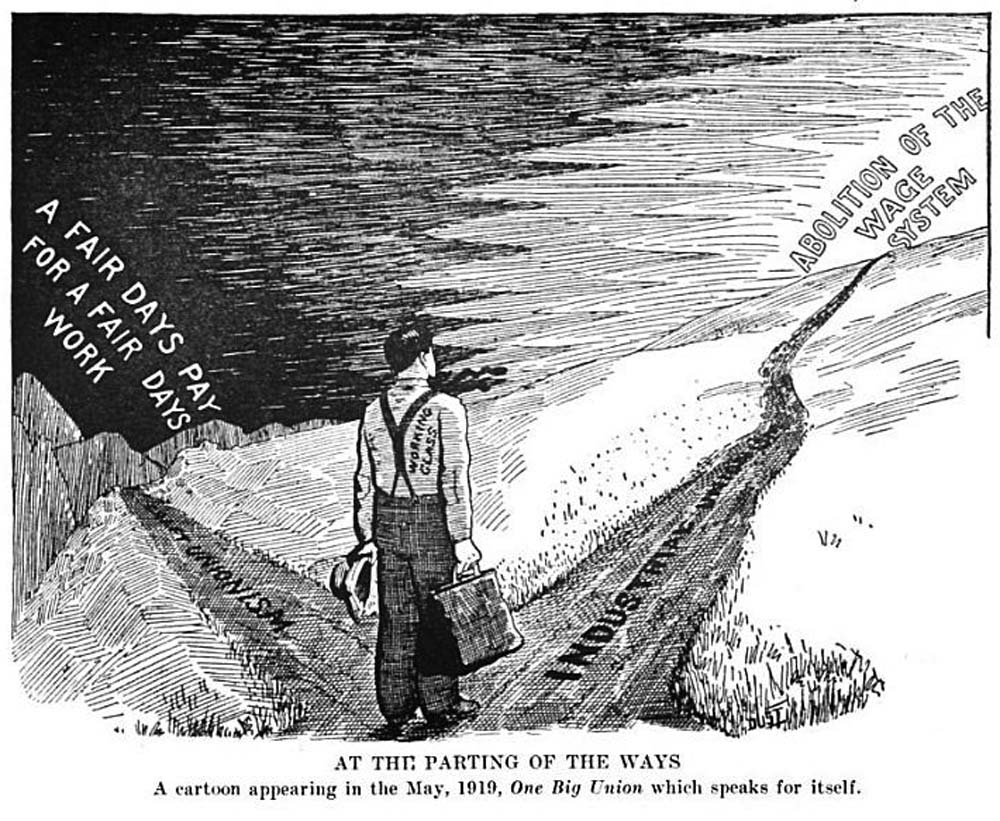|
I.W.W.
The Industrial Workers of the World (IWW), members of which are commonly termed "Wobblies", is an international labor union that was founded in Chicago in 1905. The origin of the nickname "Wobblies" is uncertain. IWW ideology combines general unionism with industrial unionism, as it is a general union, subdivided between the various industries which employ its members. The philosophy and tactics of the IWW are described as "revolutionary industrial unionism", with ties to socialist, syndicalist, and anarchist labor movements. In the 1910s and early 1920s, the IWW achieved many of their short-term goals, particularly in the American West, and cut across traditional guild and union lines to organize workers in a variety of trades and industries. At their peak in August 1917, IWW membership was estimated at more than 150,000, with active wings in the United States, the UK, Canada, and Australia. The extremely high rate of IWW membership turnover during this era (estimated at ... [...More Info...] [...Related Items...] OR: [Wikipedia] [Google] [Baidu] |
Industrial Workers Of The World Organizational Evolution
The Industrial Workers of the World (IWW) is a union of wage workers which was formed in Chicago in 1905. The IWW experienced a number of divisions and splits during its early history. When the office of the IWW president was abolished at the convention in 1906, deposed President Sherman and his supporters, many from the Socialist Party and the Western Federation of Miners, formed a rump IWW, which ceased to exist after about a year.Paul Frederick Brissenden, ''The I.W.W. A Study of American Syndicalism'', Columbia University, 1919, pages 174-184 After the 1908 convention of the original IWW, at which Socialist Labor Party (SLP) head Daniel DeLeon was barred from voting via credentials challenges, DeLeon and the SLP bolted to form another rump IWW, which came to be called the Detroit IWW. In 1915, the Detroit IWW changed its name to the Workers' International Industrial Union (WIIU). The WIIU continued its close relationship with the SLP, but ceased to exist in 1924. There was ano ... [...More Info...] [...Related Items...] OR: [Wikipedia] [Google] [Baidu] |
Industrial Workers Of The World Philosophy And Tactics
The Industrial Workers of the World (IWW) is a union of wage workers which was formed in Chicago in 1905 by militant unionists and their supporters due to anger over the conservatism, philosophy, and craft-based structure of the American Federation of Labor (AFL). Throughout the early part of the 20th century, the philosophy and tactics of the IWW were frequently in direct conflict with those of the AFL (forerunner of the AFL–CIO) concerning the best ways to organize workers, and how to best improve the society in which they toiled. The AFL had one guiding principle—"pure and simple trade unionism", often summarized with the slogan " a fair day's pay for a fair day's work." The IWW embraced two guiding principles, fighting like the AFL for better wages, hours, and conditions, but also promoting an eventual, permanent solution to the problems of strikes, injunctions, bull pens, and union scabbing. The AFL and the IWW (whose members are referred to as Wobblies) had very diff ... [...More Info...] [...Related Items...] OR: [Wikipedia] [Google] [Baidu] |
Industrial Unionism
Industrial unionism is a trade union organizing method through which all workers in the same industry are organized into the same union, regardless of skill or trade, thus giving workers in one industry, or in all industries, more leverage in bargaining and in strike situations. Industrial unionism contrasts with craft unionism, which organizes workers along lines of their specific trades. History Early history Eugene Debs formed the American Railway Union (ARU) as an industrial organization in response to limitations of craft unions. Railroad engineers and firemen had called a strike, but other employees, particularly conductors who were organized into a different craft, did not join that strike. The conductors piloted scab engineers on the train routes, helping their employers to break the strike. In June 1894, the newly formed, industrially organized ARU voted to join in solidarity with an ongoing strike against the Pullman company. The sympathy strike demonstrated the ... [...More Info...] [...Related Items...] OR: [Wikipedia] [Google] [Baidu] |
One Big Union (concept)
The One Big Union was an idea in the late 19th and early 20th centuries amongst trade unionists to unite the interests of workers and offer solutions to all labour problems. Unions initially organized as craft unions. Workers were organized by their skill: carpenters, plumbers, bricklayers, each into their respective unions. Capitalists could often divide craft unionists along these lines in demarcation disputes. As capitalist enterprises and state bureaucracies became more centralized and larger, some workers felt that their institutions needed to become similarly large. A simultaneous disenchantment with the perceived weakness of craft unions caused many unions to organize along industrial lines. The idea of the "one big union" is championed by anarchist syndicalists to organize effectively. As envisioned by the Industrial Workers of the World (IWW), which for many years prior to 1919 had been associated with the concept, One Big Union was not just the idea that all workers s ... [...More Info...] [...Related Items...] OR: [Wikipedia] [Google] [Baidu] |
First Red Scare
The First Red Scare was a period during History of the United States (1918–1945), the early 20th-century history of the United States marked by a widespread fear of Far-left politics, far-left movements, including Bolshevik, Bolshevism and anarchism, due to real and imagined events; real events included the Russian 1917 October Revolution and 1919 United States anarchist bombings, anarchist bombings. At its height in 1919–1920, concerns over the effects of radical political agitation in American society and the alleged spread of socialism, communism and Anarchism in the United States, anarchism in the American labor movement fueled a general sense of concern. The Scare had its origins in the hyper-nationalism of World War I as well as the Russian Revolution. At the war's end, following the October Revolution, American authorities saw the threat of communist revolution in the actions of Trade union, organized labor, including such disparate cases as the Seattle General Stri ... [...More Info...] [...Related Items...] OR: [Wikipedia] [Google] [Baidu] |
Industrial Worker
The ''Industrial Worker'', "the voice of revolutionary industrial unionism", is the magazine of the Industrial Workers of the World (IWW). It is currently released quarterly. The publication is printed and edited by union labor, and is frequently distributed at radical bookstores, demonstrations, strikes and labor rallies. It covers industrial conditions, strikes, workplace organizing experiences, and features on labor history. It used to be released as a newspaper. The newspaper was first printed in journal format in Joliet, Illinois, beginning in January 1906, incorporating ''The Voice of Labor'', the newspaper from the former American Labor Union which had joined the IWW, and ''International Metal Worker''. It was edited by A. S. Edwards, and early contributors include Eugene V. Debs, Jack London, Daniel DeLeon, Bill Haywood, and James H. Walsh, along with poetry by Covington Hall. When the group led by ousted President Charles O. Sherman retained physical control over the ... [...More Info...] [...Related Items...] OR: [Wikipedia] [Google] [Baidu] |
Anarchism In The United States
Anarchism in the United States began in the mid-19th century and started to grow in influence as it entered the American labor movements, growing an anarcho-communist current as well as gaining notoriety for violent propaganda of the deed and campaigning for diverse social reforms in the early 20th century. By around the start of the 20th century, the heyday of individualist anarchism had passed and anarcho-communism and other social anarchist currents emerged as the dominant anarchist tendency. Social anarchists, like Emma Goldman, can be credited with the introduction of LGBTQ social movements to the United States. In the post-World War II era, anarchism regained influence through new developments such as anarcho-pacifism, the American New Left and the counterculture of the 1960s. Contemporary anarchism in the United States influenced and became influenced and renewed by developments both inside and outside the worldwide anarchist movement such as platformism, insurrectiona ... [...More Info...] [...Related Items...] OR: [Wikipedia] [Google] [Baidu] |
Industrial Democracy
Industrial democracy is an arrangement which involves workers making decisions, sharing responsibility and authority in the workplace. While in participative management organizational designs workers are listened to and take part in the decision-making process, in organizations employing industrial democracy they also have the final decisive power (they decide about organizational design and hierarchy as well). In company law, the term generally used is co-determination, following the German word ''Mitbestimmung''. In Germany, companies with more than 2000 employees (or more than 1000 employees in the coal and steel industries) have half of their supervisory boards of directors (which elect management) elected by the shareholders and half by the workers. Although industrial democracy generally refers to the organization model in which workplaces are run directly by the people who work in them in place of private or state ownership of the means of production, there are also rep ... [...More Info...] [...Related Items...] OR: [Wikipedia] [Google] [Baidu] |
Social Class
A social class is a grouping of people into a set of Dominance hierarchy, hierarchical social categories, the most common being the Upper class, upper, Middle class, middle and Working class, lower classes. Membership in a social class can for example be dependent on education, wealth, occupation, income, and belonging to a particular subculture or social network. "Class" is a subject of analysis for List of sociologists, sociologists, political scientists, anthropologists and Social history, social historians. The term has a wide range of sometimes conflicting meanings, and there is no broad consensus on a definition of "class". Some people argue that due to social mobility, class boundaries do not exist. In common parlance, the term "social class" is usually synonymous with "Socioeconomic status, socio-economic class", defined as "people having the same social, economic, cultural, political or educational status", e.g., "the working class"; "an emerging professional class". H ... [...More Info...] [...Related Items...] OR: [Wikipedia] [Google] [Baidu] |
Capitalism
Capitalism is an economic system based on the private ownership of the means of production and their operation for Profit (economics), profit. Central characteristics of capitalism include capital accumulation, competitive markets, price system, private property, Property rights (economics), property rights recognition, voluntary exchange, and wage labor. In a market economy, decision-making and investments are determined by owners of wealth, property, or ability to maneuver capital or production ability in Capital market, capital and financial markets—whereas prices and the distribution of goods and services are mainly determined by competition in goods and services markets. Economists, historians, political economists and sociologists have adopted different perspectives in their analyses of capitalism and have recognized various forms of it in practice. These include ''Laissez-faire capitalism, laissez-faire'' or free-market capitalism, anarcho-capitalism, state capi ... [...More Info...] [...Related Items...] OR: [Wikipedia] [Google] [Baidu] |
Wage Labor
Wage labour (also wage labor in American English), usually referred to as paid work, paid employment, or paid labour, refers to the socioeconomic relationship between a worker and an employer in which the worker sells their labour power under a formal or informal employment contract. These transactions usually occur in a labour market where wages or salaries are market-determined. In exchange for the money paid as wages (usual for short-term work-contracts) or salaries (in permanent employment contracts), the work product generally becomes the undifferentiated property of the employer. A wage labourer is a person whose primary means of income is from the selling of their labour in this way. Characteristics In modern mixed economies such as those of the OECD countries, it is currently the most common form of work arrangement. Although most labour is organised as per this structure, the wage work arrangements of CEOs, professional employees, and professional contract worker ... [...More Info...] [...Related Items...] OR: [Wikipedia] [Google] [Baidu] |







